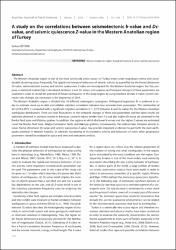A study on the correlations between seismotectonic b-value and Dc-value, and seismic quiescence Z-value in the Western Anatolian region of Turkey

View/
Access
info:eu-repo/semantics/closedAccessDate
2015Access
info:eu-repo/semantics/closedAccessMetadata
Show full item recordAbstract
The Western Anatolian region is one of the most seismically active sectors of Turkey where small-magnitude events with considerable clustering occur frequently. The spatial and temporal behaviors of seismic activity as quantified by the fractal dimension Dc-value, seismotectonic b-value and seismic quiescence Z-value are investigated for the Western Anatolian region. For this purpose, a statistical relationship is developed between b and Dc-values, and regional and temporal changes of these parameters are analyzed in order to reveal the potential of future earthquakes in the study region. By using standard deviate Z-value, current seismicity rate changes are estimated in the beginning of 2014. The Western Anatolian region is divided into 18 different seismogenic subregions. Orthogonal regression fit is preferred in order to estimate more up-to-date and reliable statistical correlation between two seismotectonic parameters. The relationship of Dc= 2.74-0.29*b is computed with a significant negative correlation (r = -0.73) between b and Dc-values for the Western Anatolian earthquake distributions. There are clear fluctuations in the temporal changes of these two parameters and the same results are relatively obtained in previous studies in literature. Lower b-values smaller than 1.0 and also higher Dc-value are observed in the Burdur fault zone and Kutahya graben. In addition, the regions in which the lower b-values and the higher Z-values are estimated cover the Burdur fault zone, Aliaga-Dumlupinar faults and Bakircay grabens. Consequently, the relationships between seismic b-value, fractal dimension Dc-value and seismic quiescence Z-value may provide important evidences to put forth the next earthquake potential in Western Anatolia. In addition, monitoring of microseismic activity and behaviors of some other geophysical parameters should be analyzed in space and time and evaluated carefully.

















